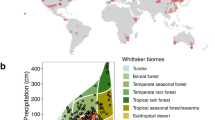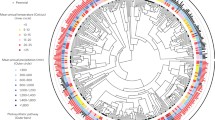Abstract
It is well known that leaf photosynthesis per unit dry mass (Amass) is positively correlated with nitrogen concentration (Nmass) across naturally growing plants. In this article we show that this relationship is paradoxical because, if other traits are identical among species, plants with a higher Amass should have a lower Nmass, because of dilution by the assimilated carbon. To find a factor to overcome the dilution effect, we analyze the Nmass–Amass relationship using simple mathematical models and literature data. We propose two equations derived from plant-growth models. Model prediction is compared with the data set of leaf trait spectrum obtained on a global scale. The model predicts that plants with a higher Amass should have a higher specific nitrogen absorption rate in roots (SAR), less biomass allocation to leaves, and/or greater nitrogen allocation to leaves. From the literature survey, SAR is suggested as the most likely factor. If SAR is the sole factor maintaining the positive relationship between Nmass and Amass, the variation in SAR is predicted to be much greater than that in Amass; given that Amass varies 130-fold, SAR may vary more than 2000-fold. We predict that there is coordination between leaf and root activities among species on a global scale.




Similar content being viewed by others
Abbreviations
- Amass :
-
CO2 uptake rate per unit standing leaf mass
- k :
-
Conversion coefficient from CO2 to biomass
- LL:
-
Leaf life span
- LM:
-
Standing leaf mass
- LMF:
-
Fraction of biomass allocated to leaves
- LMP:
-
Leaf mass production
- LN:
-
Standing leaf N
- LNF:
-
Fraction of N allocated to leaves
- LNP:
-
Leaf N production
- MRT:
-
Mean residence time of N in leaves
- Nmass :
-
Leaf N concentration per unit leaf dry mass
- PM:
-
Standing plant mass
- PMP:
-
Plant biomass production
- PN:
-
Standing plant nitrogen
- PNP:
-
Plant N production
- R :
-
N resorption efficiency
- RL:
-
Root life span
- RM:
-
Standing root mass
- RMF:
-
Fraction of biomass allocated to roots
- RMP:
-
Root mass production
- SAR:
-
N uptake rate per unit standing root mass
References
Ackerly DD, Bazzaz FA (1995) Leaf dynamics, self shading and carbon gain in seedlings of a tropical pioneer tree. Oecologia 101:289–298
Aerts R (1996) Nutrient resorption from senescing leaves of perennials: are there general patterns? J Ecol 84:597–608
Aerts R, Chapin FSIII (2000) The mineral nutrition of wild plants revisited: a re-evaluation of processes and patterns. Adv Ecol Res 30:1–67
Berendse E, Aerts R (1987) Nitrogen use efficiency: a biologically meaningful definition? Funct Ecol 1:293–296
Comas LH, Eissenstat DM (2004) Linking fine root traits to maximum potential growth rate among 11 mature temperate tree species. Funct Ecol 18:388–397
Comas LH, Bouma TJ, Eissenstat DM (2002) Linking root traits to potential growth rate in six temperate tree species. Oecologia 132:34–43
Craine JM, Lee WG, Bond WJ, Williams RJ, Johnson LC (2005) Environmental constraints on a global relationship among leaf and root traits of grasses. Ecology 86:12–19
Eissenstat DM (1992) Costs and benefits of constructing roots of small diameter. J Plant Nutr 15:763–782
Evans JR (1989) Photosynthesis and nitrogen relationships in leaves of C3 plants. Oecologia 78:9–19
Field C, Mooney HA (1986) The photosynthesis–nitrogen relationship in wild plants. In: Givnish TJ (ed) On the economy of form and function. Cambridge University Press, Cambridge, pp 25–55
Garnier E (1991) Resource capture, biomass allocation and growth in herbaceous plants. Trend Ecol Evol 6:126–131
Givnish TJ (2002) Adaptive significance of evergreen vs. deciduous leaves: solving the triple paradox. Silva Fennica 36:703–743
Hikosaka K (2003) A model of dynamics of leaves and nitrogen in a plant canopy: an integration of canopy photosynthesis, leaf life span, and nitrogen use efficiency. Amer Nat 162:149–164
Hikosaka K (2004) Interspecific difference in the photosynthesis–nitrogen relationship: patterns, physiological causes, and ecological importance. J Plant Res 117:481–494
Hikosaka K (2005) Leaf canopy as a dynamic system: ecophysiology and optimality in leaf turnover. Ann Bot 95:521–533
Hirose T (1987) A vegetative plant growth mode: adaptive significance of phenotypic plasticity in matter partitioning. Funct Ecol 1:195–202
Hirose T, Werger MJA (1987) Nitrogen use efficiency in instantaneous and daily photosynthesis of leaves in the canopy of Solidago altissima stand. Physiol Plant 70:215–222
Jackson RB, Manwaring JH, Caldwell MM (1990) Rapid physiological adjustment of roots of localized soil enrichment. Nature 344:58–60
Kinugasa T, Hikosaka K, Hirose T (2005) Respiration and reproductive effort in Xanthium canadense. Ann Bot 96:81–89
Mediavilla S, Escudero A (2003) Photosynthetic capacity, integrated over the lifetime of a leaf, is predicted to be independent of leaf longevity in some tree species. New Phytol 159:203–211
Oikawa S, Hikosaka K, Hirose T (2005) Dynamics of leaf area in a canopy of an annual herb, Xanthium canadense. Oecologia 143:517–526
Osone Y, Tateno M (2005) Nitrogen absorption by roots as a cause of interspecific variations in leaf nitrogen concentration and photosynthetic capacity. Funct Ecol 19:460–470
Osone Y, Ishida A, Tateno M (2008) Correlation between relative growth rate and specific leaf area requires associations of specific leaf area with nitrogen absorption rate of roots. New Phytol 179:417–427
Poorter H, Remkes C (1990) Leaf area ratio and net assimilation rate of 24 wild species differing in relative growth rate. Oecologia 83:553–559
Poorter H, Villar A (1994) The fate of acquired carbon in plants: chemical composition and construction costs. In: Bazzaz FA, Grace J (eds) Plant resource allocation. Academic Press, New York, pp 39–72
Poorter H, van der Werf A, Atkin OK, Lambers H (1991) Respiratory energy requirements of roots vary with the potential growth rate of a plant species. Physiol Plant 83:469–475
Reich PB, Uhl C, Walters MB, Ellsworth DS (1991) Leaf lifespan as a determinant of leaf structure and function among 23 Amazonian tree species. Oecologia 86:16–24
Reich PB, Walters MB, Ellsworth DS (1992) Leaf life-span in relation to leaf, plant, and stand characteristics among diverse ecosystems. Ecol Monogr 62:365–392
Reich PB, Walters MB, Ellsworth DS (1997) From tropics to tundra: global convergence in plant functioning. Proc Natl Acad Sci USA 94:13730–13734
Reich PB, Walters MB, Tjoelker MG, Vanderklein D, Buschena C (1998) Photosynthesis and respiration rates depend on leaf and root morphology and nitrogen concentration in nine boreal tree species differing in relative growth rate. Funct Ecol 12:395–405
Ryser P (1996) The importance of tissue density for growth and life span of leaves and roots: a comparison of five ecologically contrasting grasses. Funct Ecol 10:713–723
Shipley B (2006) Trade-offs between net assimilation rate and specific leaf area in determining relative growth rate: relationship with daily irradiance. Funct Ecol 16:682–689
Tjoelker MG, Craine JM, Wedin D, Reich PB, Tilman D (2005) Linking leaf and root trait syndromes among 39 grassland and savannah species. New Phytol 167:493–508
van der Krift TA, Berendse F (2002) Root life spans of four grass species from habitats differing in nutrient availability. Funct Ecol 16:198–203
Wells CE, Eissenstat DM (2001) Marked differences in survivorship among apple roots of different diameters. Ecology 82:882–892
Wikström F, Ågren GI (1995) The relationship between the growth rate of young plants and their total-N concentration is unique and simple: a comment. Ann Bot 75:541–544
Wright IJ, Cannon K (2001) Relationships between leaf lifespan and structural defences in a low-nutrient, sclerophyll flora. Funct Ecol 15:351–359
Wright IJ, Westoby M (2000) Cross-species relationships between seedling relative growth rate, nitrogen productivity and root versus leaf function in 28 Australian woody species. Funct Ecol 14:97–107
Wright IJ, Westoby M (2003) Nutrient concentration, resorption and lifespan: leaf traits of Australian sclerophyll species. Funct Ecol 17:10–19
Wright IJ, Reich PB, Westoby M (2001) Strategy shifts in leaf physiology, structure and nutrient content between species of high- and low-rainfall and high- and low-nutrient habitats. Funct Ecol 15:423–434
Wright IJ, Reich PB, Westoby B et al (2004) The worldwide leaf economics spectrum. Nature 428:821–827
Wright IJ, Reich PB, Cornelissen JHC et al (2005) Assessing the generality of global leaf trait relationships. New Phytol 166:485–496
Acknowledgment
We thank H. Nagashima, N.P.R. Anten and Y. Yasumura for valuable comments. This study was supported in part by grants from the Japan Ministry of Education, Culture, Sports, Science and Technology and by the Global Environment Research Fund (F-052) from the Japan Ministry of the Environment.
Author information
Authors and Affiliations
Corresponding author
Additional information
Kouki Hikosaka is the recipient of the BSJ Award for Young Scientist, 2006.
Rights and permissions
About this article
Cite this article
Hikosaka, K., Osone, Y. A paradox of leaf-trait convergence: why is leaf nitrogen concentration higher in species with higher photosynthetic capacity?. J Plant Res 122, 245–251 (2009). https://doi.org/10.1007/s10265-009-0222-z
Received:
Accepted:
Published:
Issue Date:
DOI: https://doi.org/10.1007/s10265-009-0222-z




